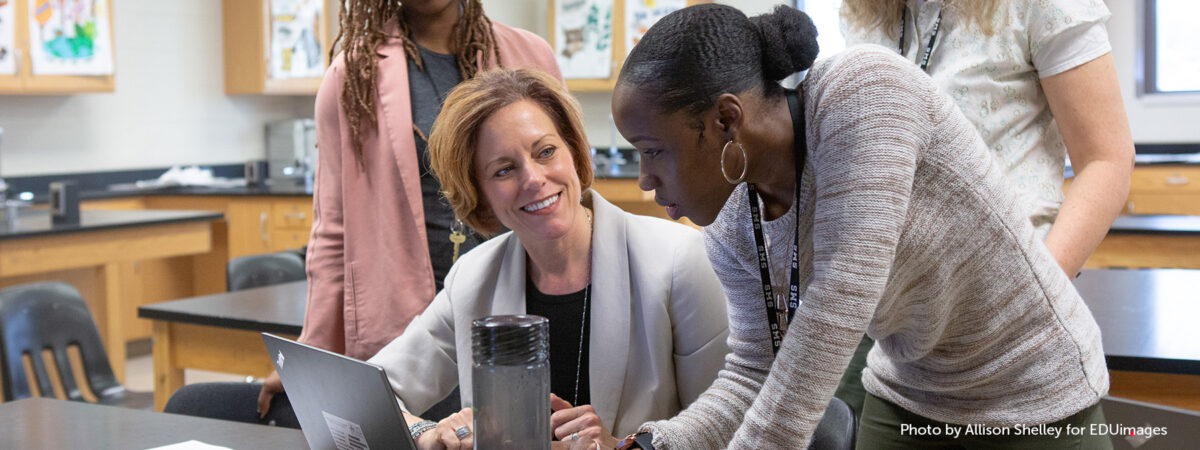
Digital Promise is committed to bridging the gap between research and practice by forming collaborative relationships that aim to better support learners who have been historically and systematically excluded. To achieve this goal, we must all work together. The Hearing Each Other’s Voices (HEOV) project seeks to harness the expertise of coaches and researchers by creating partnerships between them and, in later years, growing a new community of teachers, coaches, and researchers in practice together. Through this work, we will learn how communities of practitioners and researchers work together to design new strategies for their schools and work to close the gap between the research and practice communities.
Partnering with Indiana University, the Hearing Each Other’s Voices project connects STEM coaches in Digital Promise’s Verizon Innovative Learning Schools network with STEM education researchers. We create one-to-one pairings between a STEM coach and a researcher to address a possibility for growth identified by the STEM coach for their school. Through this collaboration, the researcher and coach share their knowledge and expertise to create new strategies for improvement.
We prioritize dismantling power imbalances between coaches and researchers. Traditionally, research has often been a one-way street, conducted “on” educators rather than alongside them. Instead, the HEOV project creates direct partnerships where coaches set the starting point to lead the research design and process. In addition to honoring the knowledge and expertise that coaches bring, our process helps ensure that the research is practical, relevant, and directly supports educators in K-12 schools.
This year we are partnering with two coaches and two researchers. Coach A is paired with Researcher A, and Coach B is paired with Researcher B. Each pair mutually selected to work with each other. Learn a little more about them below. Note: Quotes have been lightly edited for length and clarity.
Coach A: I am a technology coach at a middle school in an urban city. It is located in a high-crime and high-poverty area. 100 percent of our students receive free or reduced lunch. Out of 486 students, 134 live in shelters. Some of the problems of practice I am interested in addressing include supporting the teachers I coach to feel more comfortable using technology and supporting students to feel ownership and accountability with technology in the classroom.
Researcher A: My research focuses on the scaffolds and supports teachers need to adopt technology in their classrooms for a wide range of reasons, including improving learning outcomes, increasing diverse student interest in STEM, and their own professional growth. Because of my experiences in the classroom, I am uniquely positioned to support teachers in scaffolding learning around technology.
Coach B: I coach at a K-8 school that enrolls students new to the country. The school focuses on language development and preparing students to have a successful transition and acclimation to their neighborhood school. Currently, Spanish is the main language in the school, and typically 12-15 languages can be spoken within a single classroom. I want to work on bridging language support for STEM topics within the schools. How can the science/STEM curriculum be beneficial for English language development as well?
Researcher B: My work focuses on supporting pre-service and early career teachers in valuing and actively including multiple ways of knowing and doing in their science classes. This includes strategies for recognizing and incorporating multiple linguistic and cultural resources as assets in science teaching and learning. I draw on a combination of equity- and science-focused frameworks to support teachers in developing units that build in multiple ways for students to engage with science content and practices.
Educators and researchers are increasingly focusing on possibilities, rather than problems, in educational spaces. Through the Hearing Each Other’s Voices project, we shift away from viewing educational practices through a deficit lens, which highlights what is lacking or problematic, and instead encourage a solution-oriented approach to classroom challenges that emphasizes the potential in educational environments
By concentrating on possibilities, this outlook encourages innovation, creativity, and resilience. It fosters an educational atmosphere where challenges are seen as opportunities for growth and improvement. This positive perspective not only motivates educators and students but also promotes a more holistic and inclusive understanding of educational practice. Ultimately, it leads to more effective and sustainable outcomes.
This material is supported by National Science Foundation awards 2300618 and 2300619. Any opinions, findings, conclusions, or recommendations are those of the authors and do not necessarily reflect the views of NSF.
Sign up for our Learning Sciences Connection newsletter and follow Digital Promise on LinkedIn to stay updated on the Hearing Each Other’s Voices project.
McClain, J., Miller, J., Hmelo-Silver, C., Danish, J., Walter, W., Fusco, J., Dragnic-Cindric,D., Ruiz, P., Buli, T., Karim, S., Bae, H., Glazewski, K., (2024). The Ties that Bind: Bringing Research into Practical Spaces. In Christopher Hoadley, & X. Christine Wang (Eds.), General Proceedings of the 4th Annual Meeting of the International Society of the Learning Sciences 2024. Buffalo, USA: International Society of the Learning Sciences.